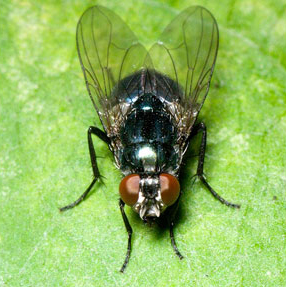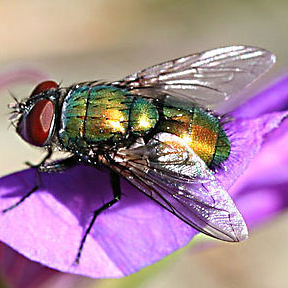Where there is raw meat, there are blowflies.
Blowfly Creek
This specimen, also called a bottle fly because of the glassy blue iridescence of its thorax, represents the worldwide total of more than 1,100 known species of blowflies, 90 of which are found in the U.S. It is also appropriately known as one of the many species of “filth flies,” for reasons that the common name suggests. To them, and to our benefit, “filth” is the “good life,” for all that.
The genus Calliphora consists of ten species, of which C. vomitoria,” named by Carl Linnæus, identifiable not only by the blue-black color of its thorax and abdomen, but also by its tawny red beard (not visible in this figure). The life cycle of a blow fly from pupa to adult occupies from 10 to 25 days, which allows from 4 to 8 new generations each season. An adult may range from 10 to 14 mm (.39–.55 in) from its face to the tips of its folded wings.
Occasionally both of the captains recorded anecdotal comments relating to the appearances or habits of certain insects they recognized, which sometimes serve as clues as to their probable identities. On 20 May 1805, for instance, the captains named a certain watercourse Blowing Fly Creek (in present Garfield County, Montana), “from the immence quantities of those insects found in this neighbourhood.” As Lewis explained, “they infest our meat while roasting or boiling, and we are obliged to brush them off our provision as we eat.” Those few details confirm that they were members of the insect family now called Calliphoridae (cal-li-FOUR-ih-dye, meaning “humpbacked”), a group of metallic blue, green, or black flies with similar habits.[1]Another family of flies that might have qualified are the Sarcophagidae (sar-ko-fag-ih-dee; “flesh eaters”), which are closely related to the Calliphoridae (cali-four-id-eye). Their life … Continue reading By 7 August 1805 this species filled a void in Lewis’s triumvirate of daily annoyances: “the musquetoes are not as troublesome as they were below, but are still in considerable quantities. the eye knats have disappeared. the green or blowing flies are still in swarms.
Jefferson River
On 7 August 1805 along the Jefferson River, Lewis observed “the large biteing fly or hare fly as they [are] sometimes called,” which were very troublesome to the men, and identified two kinds of them in the vaguest of terms, “a large black species and a small brown species with a green head.” But he didn’t describe any insects systematically, nor provide any physical measures of “large” versus “small.” However, on that same date he added another detail about the blowflies that had swarmed around their food daily since May—they were green.
Long Camp
Near the end of his leisurely stay among the Nez Perce people in the cantonment that Elliott Coues dubbed “Camp Chopunnish,” Lewis proved his dedication to the value that Thomas Jefferson had credited him with. He began with the observation that “most of the insects common to the U’ States are found here.” They included, he wrote, “the butterflies, common house and blowing flies, the horse flies, except the goald coloured ear fly, tho’ in stead of this fly we have a brown coloured fly about the same size which attatches itself to that part of the horse and is equally as troublesome.”
Fly Blown Meat
Also known by the alternative generic name Phaenicia, and by the common specific name “bottlefly.” Some species are known by their color, such as the “blue blowfly,” Calliphora vomitoria Linn. sometimes “bluebottle” or–owing to its luminescent, colored-glass sheen–”greenbottle” flies. In fact, the family name, Calliphoridae (cal-ih-FLOOR-ih-die), is a Greek word meaning “beautiful appearance.” At ¼” to ⅜” in length it is only slightly larger than the adult house fly. Blowfly larvae have hook shaped mouth parts with which they burrow into necrotic flesh, although they are seldom drawn to healthy tissue. In any case, adult blowflies do not bite, so they are not much more problematic than common house flies. However, both species can vector a number of serious diseases by transferring pathogens through direct physical contacts with their hosts.
The blowfly must not be confused with the insidious botfly, of the large (8–25 mm; .3–.98 in), stout bodied family Oestridae, that are said to resemble bees. Botfly larvae are particularly injurious to horses. None of the journalists mentioned having noticed any botflies on the their horseback trip between the Lemhi River valley and the Clearwater Canoe Camp.
There was yet another repulsive reason to damn the blowfly. The species owns an exceptionally acute sense of smell, enabling them to locate rotting flesh from great distances, and to reach those feeding and nesting grounds ahead of most other scavengers. And living flesh begins to decay the moment after it life is done. For that reason blowflies and their soft bodied, legless maggots,[2]Maggot is a common name of pejorative implication, and has no scientific validity. Its etymology is uncertain and thus debatable. which are the larvae of the species, are of great importance to forensic entomologists, who can estimate the time of a corpse’s death by observing the developmental stages of larvae and—the last stage in this fly’s metamorphosis—pupae. The analysis is most accurate within the first three days following death, and of steadily diminishing worth thereafter.[3]To be seriously objective, that is, at least for the forensic entomologist, a plus for the blowfly’s value to humans.
Blowflies gained their common name in Elizabethan times, when meat was sold in open-air markets. It was all just dead flesh to these voracious scavengers. In less than half a day the females could completely cover all of a careless butcher’s unattended meat with their rice-grain sized eggs, as if they had come in on the breeze. The sight was enough to make a person ill. Thus the specific epithet vomitoria. Given the adult fly’s habit of feeding on filth, the meat could be branded by the observant shopper with two simple words–”fly blown.”
Maggot Therapy
But there is one more service that those maggots have supplied to humankind since Classical antiquity, at least, and that is simply lifesaving. By accident at first, soon confirmed by close observation, the maggots’ appetite for necrotic flesh has been employed right up to the present time in the arresting of infection in human as well as animal flesh wounds. The procedure is known as maggot or larval therapy, biodebridement (the removal of necrotic (dead) flesh from a wound or abscess by means of a living organism) or–more tastefully–biosurgery.[4]Whitaker IS, Twine C, Whitaker MJ, Welck M, Brown CS, Shandall A (2007). “Larval therapy from antiquity to the present day: mechanisms of action, clinical applications and future … Continue reading Those old, old feelings about maggots are hard to suppress, but its essential to the therapist, who must not bandage the wound at issue, nor do anything to deprive the maggots of oxygen. Furthermore, when the maggots have eaten their fill, and fattened by 8 or 10 times, within three to four days, they will spontaneously leave the site, so the therapist must be acutely observant. In the 1930s, biosurgery for wound infections was commercialized in the U.S. with the cultivation of larvae of the green bottle fly. The discovery of effective antibiotics such as penicillin in the 1940s gradually led to the displacement of maggot therapy until the appearance of bacteria that resisted the benefits of antibiotics. In 2004 the U.S. Food and Drug Administration approved the production and marketing of maggots for treatment of humans and animals on a prescription-only basis, and by 2007 the larvae were proving their ability to devour many of the new bacteria.
Notes
| ↑1 | Another family of flies that might have qualified are the Sarcophagidae (sar-ko-fag-ih-dee; “flesh eaters”), which are closely related to the Calliphoridae (cali-four-id-eye). Their life cycles have been studied closely, with the result that, given knowledge of the ambient temperature of the environment in which a corpse has been discovered, forensic entomologists can determine the date and approximate time of a victim’s death. Sarcophagidae have played important roles in television dramas such as the series CSI: Crime Scene Investigation, wherein the principal investigator, fictional Gil Grissom, sometimes uses them as part of a solution to a murder. |
|---|---|
| ↑2 | Maggot is a common name of pejorative implication, and has no scientific validity. Its etymology is uncertain and thus debatable. |
| ↑3 | To be seriously objective, that is, at least for the forensic entomologist, a plus for the blowfly’s value to humans. |
| ↑4 | Whitaker IS, Twine C, Whitaker MJ, Welck M, Brown CS, Shandall A (2007). “Larval therapy from antiquity to the present day: mechanisms of action, clinical applications and future potential”. Postgraduate Medical Journal 83 (980): 409–13. doi:10.1136/pgmj.2006.055905. PMC 2600045. PMID 17551073. |


